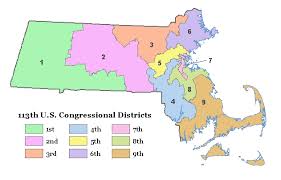 Some customers have subgroups of voters in their OpaVote online elections. For example, the subgroups could be based on where voters live (e.g., as in the congressional districts shown here) or the grade level of student voters.
Some customers have subgroups of voters in their OpaVote online elections. For example, the subgroups could be based on where voters live (e.g., as in the congressional districts shown here) or the grade level of student voters.For example, consider a high school election that elects a president for the entire school and a representative for each grade (freshmen, sophomores, juniors, and seniors). Every student can vote for president but only students of a grade vote their representative. There are thus five groups of voters (the whole school and a group for each of the four grades).
I'll present two options for doing this with OpaVote. The first is easier for the manager and the second is easier for the voters.
Hold a Separate Election for each Contest
The election manager creates an OpaVote election for each of the five contests. For a example, a first election for president (where all students are voters), a second election for freshmen representative (where only freshmen are voters), and so forth.When you do this, each voter will receive two voting links. A first voting link to vote for president and a second voting link to vote the representative of their grade. When the elections are over, you count the votes for each election to determine the winners.
While it is very easy for the manager to set up the OpaVote elections this way, it is a little more confusing for each voter to receive two voting links and have to vote twice. It is certainly doable, but you need to clearly communicate to the voters that they will receive two votings links and that they must use each of them.
If you have 100 voters in each grade level, then the price will be $40 for the president election and $10 for each grade level election for a total of $80.
Hold a Separate Election for each Group of Voters
The election manager creates an OpaVote election for each of the four groups of voters. Now, each election will have two contests: a first contest for president and a second contest for the representative of the grade. Each voter now receives one voting link and votes once (for president and grade representative). This makes it very easy for the voters.
When the elections are over, it is easy to determine the winners of the contests for the representatives of the grades. You just count the votes. To determine the winner of the contest for president, the election manager needs to do more work since the ballots are split up among the four grades.
The manager needs to combine the votes to count them all together, and this is a fairly easy process:
- Download the votes for president from each grade and give them an appropriate name (e.g., freshmen.txt, sophomores.txt, etc.).
- Create an OpaVote Count.
- Upload the ballots for the freshmen.
- Append the ballots for each of the other classes.
- Count the votes to get the winner for president.
I recommend this method over the previous method because it is just a little work for the manager and it makes it easier for the voters.
If you have 100 voters for each grade level, then the price will be $10 for each grade level election and $40 for the OpaVote Count used to combine the votes. The price for the two options is thus about the same.




